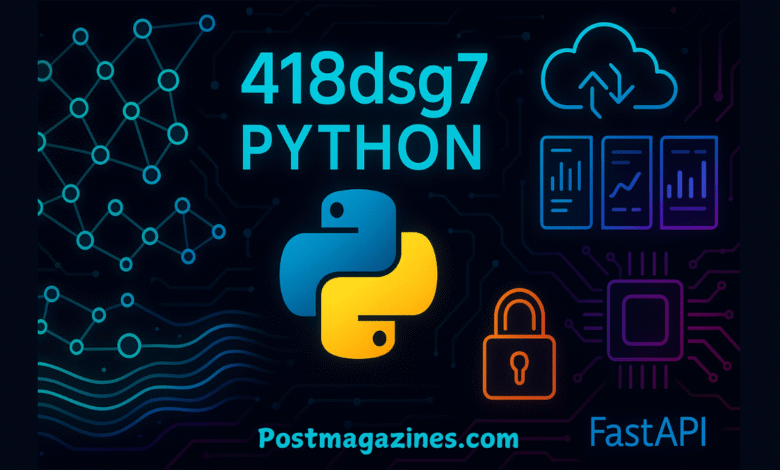418dsg7 Python: A New Era for Graph Processing and Big Data Efficiency

The world of programming is constantly evolving, and developers frequently encounter new frameworks, tools, and libraries that promise increased efficiency and innovation. One such emerging keyword that has started drawing attention is 418dsg7 python. While it may not yet be a mainstream package in the Python ecosystem, it represents a concept often discussed in terms of performance, scalability, and experimental approaches to coding. In this article, we will explore what 418dsg7 python could mean, how it might fit into the developer’s toolkit, and why it is gaining traction in blogs, discussions, and SEO-driven platforms.
What is 418dsg7 Python?
At its core, 418dsg7 python is described as a high-performance computational concept in various blogs and knowledge-sharing platforms. It is often associated with graph processing, data optimization, and scalable frameworks. While there is no official PyPI package or GitHub repository with this exact name, the keyword appears in multiple technical discussions, making it an interesting area to explore.
In practical terms, 418dsg7 Python seems to be linked with the following areas:
- Graph processing – handling complex datasets that rely on interconnected nodes.
- Data management – efficient storage and retrieval of structured and unstructured data.
- Performance optimization – attempts to improve execution speed in Python applications.
Why 418dsg7 Python is Relevant
The 418dsg7 Python is relevant for several reasons. Firstly, it aligns with ongoing developer interest in enhancing Python’s speed and scalability. Python, while versatile, has long been criticized for performance limitations compared to languages like C++ or Rust. Any approach, framework, or methodology—whether hypothetical or in development—that promises to enhance Python’s efficiency is bound to spark interest.
Secondly, many articles mentioning Python highlight its connection to data science, AI, and big data processing, fields where Python is already a dominant presence. The ability to process larger datasets with fewer resources makes the idea of 418dsg7 particularly attractive.
Features Attributed to 418dsg7 Python
Although not an officially documented package, sources repeatedly attribute certain features to 418dsg7 Python. These include:
- High-speed execution – improving Python’s runtime efficiency.
- Caching mechanisms – reducing redundant computations by storing frequently used results.
- Security layers – encryption or data integrity features for sensitive datasets.
- Scalable architecture – supporting distributed systems and parallel computation.
- Ease of integration – compatibility with existing Python libraries such as NumPy, Pandas, and TensorFlow.
If 418dsg7 Python were to become a real, established project, these features could make it a powerful addition to the Python ecosystem.
Applications of 418dsg7 Python in Data Science
In the field of data science, 418dsg7 Python is often described as particularly useful. Data scientists often work with massive datasets that require rapid preprocessing, transformation, and analysis. By leveraging a framework such as 418dsg7, they could potentially:
- Handle real-time analytics on live data streams.
- Build machine learning models faster with optimized training loops.
- Reduce infrastructure costs by processing data more efficiently.
- Manage graph databases for social network analysis, recommendation engines, and fraud detection.
The imagined applications of 418dsg7 Python align closely with current trends in big data and machine learning.
418dsg7 Python for Web Development
Beyond data science, the discussions around 418dsg7 Python also extend into web development. Modern web applications require speed, concurrency, and secure data handling. A tool or methodology like 418dsg7 could be applied to:
- Improve backend performance for high-traffic applications.
- Enhance API response times for microservices.
- Secure data transmission between servers and clients.
- Scale cloud-native applications efficiently.
In this context, 418dsg7 Python could be positioned as a competitor or companion to frameworks like Django, FastAPI, and Flask.
Comparing 418dsg7 Python with Other Frameworks
To better understand 418dsg7 Python, it’s helpful to compare it with established Python tools:
- NumPy / Pandas: Popular for data processing but limited by single-threaded execution. 418dsg7 Python claims to improve scalability and concurrency.
- Dask: Enables parallel computing on large datasets. 418dsg7 Python could be imagined as a leaner, more specialized alternative.
- TensorFlow / PyTorch: Used for machine learning. 418dsg7 Python could complement these libraries by enhancing data throughput before feeding it into models.
- FastAPI: Known for high-performance APIs. With 418dsg7, developers might see even faster and more secure API endpoints.
This comparative view shows that if 418dsg7 Python evolves into a concrete library, it has the potential to carve out a niche.
How to Get Started with 418dsg7 Python (Conceptually)
Even though an official package doesn’t exist at this time, developers can conceptually prepare to explore 418dsg7 Python by:
- Studying graph processing techniques – since 418dsg7 is often linked to advanced graph engines.
- Experimenting with caching strategies – learning how caching boosts performance in Python.
- Exploring distributed systems – frameworks such as Dask, Ray, or Apache Spark can offer valuable insights into scalability.
- Keeping an eye on SEO-driven keywords – sometimes new frameworks emerge first as experimental or academic projects before becoming mainstream.
By following these approaches, developers position themselves to adopt 418dsg7 Python or similar innovations when they officially surface.
The Hype Around 418dsg7 Python
Why has 418dsg7 Python generated so much buzz in online blogs? The answer lies partly in SEO and content marketing. New keywords like this are often promoted heavily to drive traffic, spark curiosity, and position websites as early authorities on trending topics.
However, hype is not necessarily a bad thing. Many real frameworks, such as TensorFlow and PyTorch, also started with hype before gaining widespread acceptance. The attention surrounding 418dsg7 Python could signal genuine interest from the developer community, even if the tool is not yet widely available.
The Future of 418dsg7 Python
Looking ahead, the potential for 418dsg7 Python lies in:
- Official development – whether by an open-source community or a private company.
- Wider adoption – gaining traction if it provides measurable benefits over existing libraries.
- Integration – working seamlessly with cloud platforms, data pipelines, and AI workflows.
If momentum continues, 418dsg7 Python may move from being an emerging keyword to a legitimate entry in the Python software ecosystem.
Conclusion: The Promise of 418dsg7 Python
In conclusion, 418dsg7 Python is currently more of an emerging idea than a proven framework, yet it continues to spark interest among developers and content creators alike. Its association with graph processing, scalability, and high performance makes it an intriguing topic in the Python landscape.
You May Also Read: TRWHO.com Tech: Your Gateway to the Latest Technology Trends in 2025




